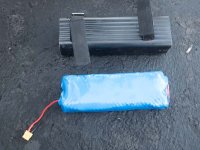Unless you buy a cheap POS battery (or poorly construct your own), there's no intrinsic reason for it to fail "early", and no reason in general why multiple small packs would be better, wrt reliability.
Actually, the opposite is true IMO. Multiple small packs have drawbacks that outweigh any "risk" of a single pack failure:
- More BMSs = more systems/components to fail. You're significantly more likely to have a failure with multiple smaller packs, statistically speaking. And if one does fail, there's also a chance that that failure will cause damage to the other packs. It has been reported on this forum that BMSs have not protected packs when a short circuit has occurred. For example, shorted wiring, blown controller, etc, then the BMS mosfets also just blow closed-circuit, instead of providing protection by switching off "open-circuit". If one BMS does this, very likely that it will cause all the others to pop too, if they're all the same hardware with same rated components.
- Higher cost for multiple smaller BMS/packs.
- More wiring (to fail).



